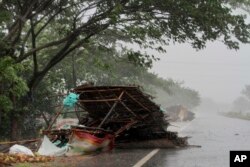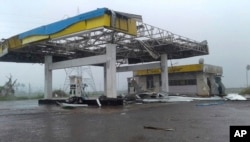Cyclone Fani has crashed into eastern coast of India as a grade 5 storm, replete with heavy rain and winds gusting to 205 kilometers per hour.
The storm hit the coast of the state of Odisha early Friday.
More than 100 million people are in the path of the cyclone.
Authorities say more than 1 million people in the low-lying coastal areas have heeded government warnings and evacuated. Authorities plan to move thousands more.
Cyclone tracker Tropical Storm Risk rated Fani as a category 4 storm, a notch below the worst level.
“Total destruction” is what Fani is capable of inflicting, according to some forecasters.
Meteorologists have warned people who live in thatched roof houses to seek sturdier accommodations. Fani is also expected to uproot power and communications poles.
Communities away from the coast are bracing for heavy flooding. Rainfall of 20 to 25 centimeters (8 to 10 inches) is expected over a widespread area.
Fani has intensified significantly over the past couple of days, prompting the India Meteorological Department (IMD) to refer to it as an “extremely severe cyclonic storm.”
Its effects were felt on Mount Everest, where climbers and guides descended to lower camps, and the government issued a warning for heavy snow.
Officials have asked tourists to leave the coastal city of Puri, home to the 13th century Konarak Temple that is a UNESCO World Heritage Site, and the Jagganath Temple, one of the most holy in Hinduism.
Two major eastern ports, Paradip and Visakhapatnam, have been ordered to move ships out to sea to avoid damage. Flights have been canceled from midnight Thursday at the airport in Odisha’s capital, Bhubaneshwar, and for Kolkata Airport from 9:30 p.m. Friday, according to India’s Ministry of Civil Aviation.
Bangladesh expects the storm to arrive there later Friday.
Eastern India is no stranger to deadly storms. In 1999, a supercyclone hit Odisha, killing more than 10,000 people. Four years later, the toll was significantly lower when Cyclone Phailin hit the state. Because of improved forecasting and evacuation system, more than 1.3 million people were moved out of harm’s way, resulting in a few dozen deaths, rather than thousands.
On Tuesday, Fani became the strongest storm in the north Indian Ocean this early in the season, passing Cyclone Nargis, which killed more than 100,000 people in Myanmar in 2008.
The north Indian Ocean cyclone season doesn’t have a defined start and end like the Atlantic hurricane season. Instead, it has two main periods of activity: late April to early June, and October to November.
Fani is the first cyclone of the 2019 season.







